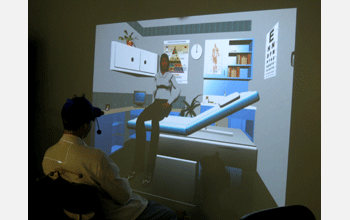Multimedia Gallery
Virtual Patients Project
A medical student speaks with a virtual patient complaining of abdominal pain. The student sees a life-sized virtual human and communicates with speech and gestures to learn communication skills. The visual was created as part of the Virtual Patients Project developed at the department of computer and information science and engineering at the University of Florida, and supported by a grant from the National Science Foundation (awarded to principal investigator Benjamin Lok).
The project involves developing highly immersive virtual human (VH) interactions that will train health profession students (medical, nursing and physician assistant) to better their communication and interpersonal skills. To teach these skills, Lok and his group built an immersive virtual patient (VP) system that simulates a standardized patient (SP) encounter. These immersive VPs are highly interactive, in 3-D VHs. In the 10-minute experience, the student speaks, gestures and can touch the VP in order to practice having a patient-doctor interview. Over 450 medical, nursing and physician assistant students, as well as residents and physicians have used the system so far at three universities: the University of Florida, the Medical College of Georgia and Keele University School of Pharmacy.
To learn more about this research, visit the project's website Here. [Research supported by NSF grant IIS 06-43557.] (Date of Image: May 2007)
Credit: Benjamin Lok, CISE, University of Florida, and David S. Lind, Medical College of Georgia
See other images like this on your iPhone or iPad download NSF Science Zone on the Apple App Store.
Images and other media in the National Science Foundation Multimedia Gallery are available for use in print and electronic material by NSF employees, members of the media, university staff, teachers and the general public. All media in the gallery are intended for personal, educational and nonprofit/non-commercial use only.
Images credited to the National Science Foundation, a federal agency, are in the public domain. The images were created by employees of the United States Government as part of their official duties or prepared by contractors as "works for hire" for NSF. You may freely use NSF-credited images and, at your discretion, credit NSF with a "Courtesy: National Science Foundation" notation.
Additional information about general usage can be found in Conditions.
Also Available:
Download the high-resolution JPG version of the image. (2.7 MB)
Use your mouse to right-click (Mac users may need to Ctrl-click) the link above and choose the option that will save the file or target to your computer.

